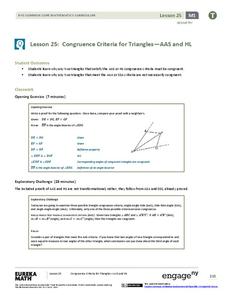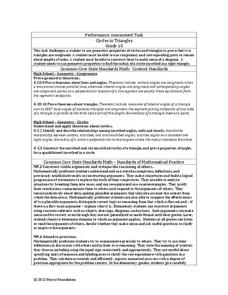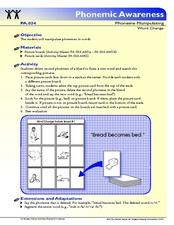Curated OER
Exploring Similar Polygons
In this exploring similar polygons worksheet, 10th graders solve 9 various problems that are related to similar polygons. First, they define similar and the symbol used to identify similar to another. Then, students find the measurement...
Curated OER
Angles and Parallel Lines
In this angles and parallel lines worksheet, 10th graders solve 12 different types of problems that include measuring various angles and parallel lines in given figures. First, they find the measure of each angle using the figure shown....
Curated OER
Proving Lines Parallel
In this proving lines parallel worksheet, 10th graders solve 10 different types of problems that prove that various lines are parallel to each other. First, they find the value of x so that line a is parallel to line b. Then, students...
Curated OER
Identifying Similar Triangles
In this identifying similar triangles worksheet, 10th graders solve 6 different types of problem that include identifying and comparing similar triangles. First, they identify the three ways that determine whether two triangles are...
Curated OER
Teaching Arithmetic and Math Concepts to Headstarters
Students discover early number concepts for numbers 1 through 5. In this number concepts activity, students work in stations doing hands-on activities such as sorting colored blocks, stringing beads, and counting sticks. Students also...
Curated OER
Thanksgiving Activity: Thanksgiving and Family
Students examine common Thanksgiving foods employing counting, singing, and discussion. Students sing "We Eat Turkey" and discuss what their families eat. Students will then be asked to create and plate of Thanksgiving food and count and...
Curated OER
Creating a 3d Model and Corresponding Topographic Map
Young scholars create a landform model and topographic map. In this topography lesson, learners use a real landform to create a model and topographic map to scale.
Florida Center for Reading Research
Phonics: Letter Recognition, Lettercritter
This is a fun idea to get your scholars practicing their ABCs! They assemble an alphabet caterpillar, printing lowercase versions below each uppercase letter. They practice writing the lowercase letters using dry-erase markers and say...
Curated OER
Transformations in the Coordinate Plane
Your learners connect the new concepts of transformations in the coordinate plane to their previous knowledge using the solid vocabulary development in this unit. Like a foreign language, mathematics has its own set of vocabulary terms...
Willow Tree
Angles Formed by Transversals of Coplanar Lines
Create a strong understanding of the relationships formed when parallel lines intersect a transversal. Discuss each type of angle pair and their relationship to each other.
West Contra Costa Unified School District
Parallel Lines Cut by a Transversal
Parallel lines seem so right for each other. It's too bad they'll never, ever meet. Learners use tracing paper to discover relationships among angles formed by two parallel lines cut by a transversal. They apply this information to find...
EngageNY
Congruence Criteria for Triangles—AAS and HL
How can you prove it? Guide classes through an exploration of two possible triangle congruence criteria: AAS and HL. Learners connect this criteria to those previous learned and also explore criteria that does not work. The lesson...
Inside Mathematics
Rhombuses
Just what does it take to show two rhombuses are similar? The assessment task asks pupils to develop an argument to show that given quadrilaterals are rhombuses. Class members also use their knowledge of similar triangles to show two...
Florida Center for Reading Research
Phonics: Encoding and Decoding, Make-A-Word
Little learners place a picture card on a magnetic board, say the name of the object on the card, then sift through alphabet magnets to find and spell the word they said.
Florida Center for Reading Research
Phonics: Encoding and Decoding, A Digraph A Word
Learners view a series of images, then choose digraphs, consonants, and vowels to spell out the object's name on each card.
Teach Engineering
Club Function
Let's get the herd to follow the rules. The activity associated with the second lesson in the unit introduces the class to the definition of a function. Individuals must gather in groups of zebras and rhinos defined by the general...
EngageNY
Properties of Parallelograms
Everyone knows that opposite sides of a parallelogram are congruent, but can you prove it? Challenge pupils to use triangle congruence to prove properties of quadrilaterals. Learners complete formal two-column proofs before moving on to...
Inside Mathematics
Circles in Triangles
Challenge the class with inscribed circles in triangles. The assessment task requests class members use their knowledge of circles and right triangles to prove two triangles are congruent. They go on to utilize their knowledge of...
EngageNY
Angles Associated with Parallel Lines
Explore angle relationships created by parallel lines and transversals. The 13th lesson of 18 prompts scholars use transparency paper to discover angle relationships related to transversals. Learners find out that these angles pairs are...
Curated OER
Using the Sounds of Words Reading Task
Young readers demonstrate phonemic awareness in words and blends, and recognize 100 high-frequency words. Use a nursery rhyme to point out rhyming words, and change the words by putting a new letter at the beginning. Each learner will...
Florida Center for Reading Research
Recognizing Letters
Boost letter recognition with an activity that challenges young scholars to match a plastic letter to one printed on a card.
Florida Center for Reading Research
Sound it-Bag it
Scholars sort picture cards based on the initial phoneme they hear as they say the name of each image. They pick a card, say its name, then place it in one of five bags based on how its initial phoneme matches the initial phoneme...
Florida Center for Reading Research
Phonological Awareness: Phoneme Manipulating, Word Change
Once your scholars know their letter sounds and recognize them in words, have them try making new words by manipulating phonemes. Pupils are given a word change picture board and a stack of word pictures. They pick a card and place it...
Florida Center for Reading Research
Phonics: Encoding and Decoding, Three-In-One
Scholars use the provided pack of alphabet cards to construct basic CVC words, then write down each word they make in one of two columns. Column one is for real words and column two is for nonsense words.

























